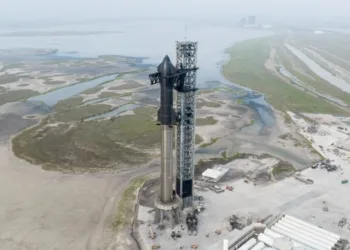Last week, SpaceX’s Super Heavy rocket took center stage during a thrilling test flight, successfully being captured by the massive mechanical arms of the launch tower on its first try.
Moments before that remarkable catch, the Super Heavy booster had delivered the upper-stage Starship spacecraft into orbit, marking the fifth test flight of the most powerful rocket on the planet.
Though it didn’t steal the spotlight, the spacecraft experienced a spectacular journey, traveling across the globe from its launch site in Boca Chica, Texas, to perform a landing burn before splashing down in the Indian Ocean. Impressively, it landed exactly at SpaceX’s designated spot, with a buoy equipped with a camera deployed to document its final descent and splashdown approximately 65 minutes post-launch.
Starship flip maneuver and landing burn on its fifth flight test. Vehicle improvements ensured flaps were protected from high heating, resulting in a controlled entry and high accuracy splashdown at the targeted area in the Indian Ocean pic.twitter.com/nLIQLLVMv1
— SpaceX (@SpaceX) October 18, 2024
According to a message from SpaceX, led by Elon Musk, “Starship performed another successful hot-staging separation, igniting its six Raptor engines and completing its ascent into space.” The spacecraft then cruised along its planned trajectory to the opposite side of the planet before executing a controlled re-entry. It navigated through peak heating and maximum aerodynamic pressure phases before performing a flip maneuver, landing burn, and ultimately splashing down in its target area in the Indian Ocean.
On its official website, SpaceX remarked that the team involved in this latest test flight should “take pride in their engineering accomplishments. The world witnessed a preview of the future when Starship begins transporting crew and cargo to destinations such as Earth, the moon, Mars, and beyond.”
Looking ahead, SpaceX has announced plans to catch the Starship spacecraft in the same manner they successfully captured the Super Heavy booster during this test. The spacecraft is also designed to land upright on solid ground, a critical capability it will need for missions to other celestial bodies, including the moon, as part of the Artemis III mission scheduled for 2026, which aims to return humans to the lunar surface.










